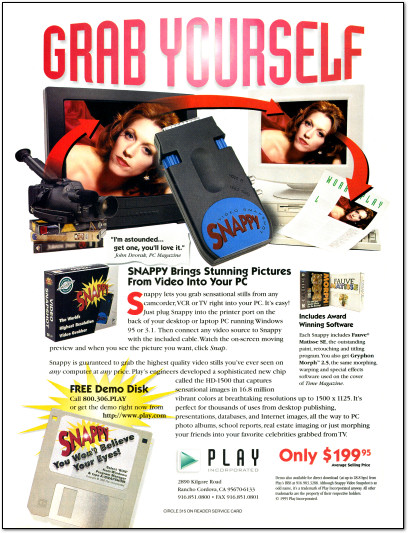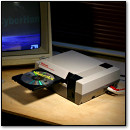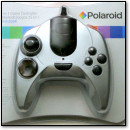[ Retro Scan of the Week ] Snappy Video Snapshot
April 11th, 2011 by Benj Edwards If Dvorak loved it (see quote), then there must be something terribly wrong.
If Dvorak loved it (see quote), then there must be something terribly wrong.
The Snappy is one of the greatest gadgets I’ve ever owned. It captured full color still images from a composite video input in a variety of resolutions and interfaced to a PC via a parallel port connection. The greatest part was its price — the MSRP in 1995 started at $199.95, which was staggeringly low for a device of that capability. In effect, the Snappy turned your family camcorder into a digital still camera at a time when digital cameras were rare and extremely expensive.
I used my Snappy to capture my first digital photos and some of the earliest directly digitized screenshots of video games ever made, which I distributed on my BBS. This was at a time before widespread emulation, so it was miraculous to have a JPEG file of, say, The Legend of Zelda’s title screen on your computer.
To see the 1979 equivalent of the Snappy, check out this Retro Scan from last December.
Discussion Topic of the Week: When did you take your first digital picture?






April 11th, 2011 at 7:20 pm
My first digital picture was probably about 1997. I had one of those early Nikon Coolpix 100 cameras that took 4 AAs and were basically a camera on top of a Flash PCMCIA card. Which incentivized me to put PC Card slots in my PC tower to read it! I still have photos I took with that thing. The device itself died in my backpack in Hawaii in 2001 when water spilled on it.
What caught my eye about this story though, was my familiarity with Play, Inc. I worked there around 1999, and talk about the typical startup stereotype! Visionary hippie near the top? Check. Customized cubicles loaded with Star Wars/Trek merch and crazy inventions? Check. I was a web developer in R&D, which meant I just came in and worked on whatever I thought was cool. I also did a fair bit on the PlayTV site, which was streaming regularly scheduled original programming before anybody ever heard of YouTube, let alone Hulu. They had a full-on reproduction of the original Enterprise bridge, for their comedy show Prime Directive, featuring members of Warp 11, the Star Trek tribute band. (Note frontwoman Kiki Stockhammer in the advert above!) It was a crazy place to work.
They had a lot of innovative products and ideas, some of which I know have never seen the light of day. Some ideas were also ahead of their time, such as a concept that today would simply have been the iPhone, I kid you not. They would have made a hell of an iOS developer, except they basically folded in the dot com bust.
April 12th, 2011 at 7:52 am
Very cool Donn.
April 12th, 2011 at 8:17 am
Awesome story, Donn. Would you like to write up a post about your time at Play for VC&G? I’d be happy to post it.
April 12th, 2011 at 10:47 am
Benj, I’ll definitely consider that, and see if I can come up with something worthy.
I just looked at the enlarged ad; note the mention of a demo available on Play’s BBS! It’s worth pointing out that by the time I got there, the Snappy was an old product – they had a giant model of it (probably for trade shows) hanging in the rafters over the TV studio. Play had moved on to sell their other great video product: the Trinity Studio-in-a-box, which allowed digital live effects and switching controlled from a PC. They used it for their own stuff, plus they had a lot of good clients using it: ABC and the Minnesota Twins are the ones that come to mind. You can actually see one in the background of the ABC comedy Sports Night, where they used it to do the show-within-a-show. (The Trinity was a blue cube about 14 inches on a side.)
Huh, guess I better write up a post…
April 14th, 2011 at 7:48 am
I used the Play to create a live webcam for a trade show back in 1996. The setup was kludgy (NTSC camera to the Play, connected to a Toshiba laptop with a script that FTPed an image to our webserver every 60 seconds). But that Play worked like a charm and the images were excellent.
April 15th, 2011 at 12:10 pm
Hah, had one of these too and was pretty impressed with it.
I used it with a video tape camera to add a simple texture video sequence to a 3DS rendering.
April 15th, 2011 at 12:57 pm
I owned a Snappy and used it in the late 90s to build a website about a cartoon I loved. It was so great to own back then, but eventually I bought a computer that had a coaxial nub on the back, making Snappy useless…also, I grew older and no longer did things like make websites about cartoons. I miss my youth terribly.
But Snappy served me well for years!
April 17th, 2011 at 2:20 pm
A Snappy was definitely my first digital “camera”. In fact, I still have the pictures from it, in whopping 320×240.
http://www.flickr.com/photos/anachostic/5628647066
April 18th, 2011 at 1:41 am
Wasn’t going to comment since the post isn’t all that recent, but since anachostic did… 🙂
My family’s first digital “camera” was also a Snappy, bought in the early-mid 90s and hooked up to the family IBM 486 DX2/50 MHz. I can’t find the pics now (I suspect they’re on our old Jaz cartridge), but a good friend and I spent one summer videotaping our former junior high & high schools and capturing images. It seemed silly afterward, but now I’m glad that we did it — one was demolished & the other was severely renovated, and I haven’t been able to find any photos of either old/original online.
December 25th, 2012 at 12:44 pm
I got a Snappy early 1999 so I could capture video stills from my tv series to put on my website about the tv series. I immediately had dozens of images for the website. I used it for half a dozen years until I started grabbing video stills with Quicktime. It was a great tool for someone on a limited budget.
My website has hundreds of photos from video stills, almost half of which were created with Snappy.
September 2nd, 2013 at 7:54 am
I was recently watching through some of my old VHS tapes (yes, those!). Back in the mid-90s I used to love watching the Star Wars specials on QVC, and recorded parts or all of them so I could have my parents order stuff for me. Anyways apparently after one of those specials, they featured the Snappy, and I started recording the show. It’s interesting to watch something considered common today that was considered revolutionary back in ~1995. Though I’m not sure if I recorded that QVC bit because I thought the Snappy was pretty awesome, or because Kiki was super hot 😉
September 30th, 2013 at 7:17 pm
Play, Inc’s folks were from NewTek, a corporation that made it’s initial start in the Amiga market. Prior to the Video Toaster’s release for the 2000 (you could shoehorn it into a 3000, or into a 3000T), they released the DigiView which was essentially the Amiga compatible Snappy.
Kiki Stockhammer was the spokesperson for NewTek at the time as well.
September 16th, 2014 at 2:10 pm
The Snappy video capture card was awesome, I would put the camera on a tripod, then film for several seconds, each scene, then I captured a high quality digital image from the camcorder. About 1999 I believe.
August 11th, 2016 at 6:56 pm
I remember getting a Snappy at Sams club when I was in highschool. We had a ton of fun taking our videos of snowboarding and skateboarding and making images for our geocities pages 🙂
September 8th, 2016 at 2:44 pm
Donn, Play, Inc. wasn’t killed off by the dot-com bust. It died because its founder and co-CEO, Paul Montgomery, dropped dead of a heart attack while on vacation with his wife in June of 1997 at the age of only 39. This was a terrible loss to the industry as a whole.
The Snappy Video Snapshot was an absolutely astounding piece of technology, and I know of no software nor hardware that could pull off what it did. Its input was composite NTSC video, right off a camcorder or other NTSC composite video camera. Somehow, from that alone, by sampling multiple frames of still video, it could produce incredibly high quality, and even high resolution, printable still images — up to 1,500×1125 resolution! That exceeds the vertical resolution of HDTV and its horizontal resolution as well if you take into account the squarer 4:3 aspect ratio instead of 16:9. NTSC is normally digitized to resolutions such as 640×480, 648×486, or 720×480 (or 486). This well over doubled that in both dimensions, roughly quintupling the pixels. And it wasn’t just upscaling. The additional pixels had real detail in them. It worked based on some custom chips, and I have no idea how it was able to do this off of composite NTSC video (not even S-Video!).
January 30th, 2020 at 12:01 pm
I just ran across my old Snappy. I took my first digital photo with it. I wonder if it’s a collectors item now. :-p
February 26th, 2020 at 8:15 pm
I just stumbled across this dusty old thread.
Joel, Paul died in 1999. I worked at Play at the time. I fixed enough problems with and “stabilized” the Snappy 3.0 release enough that myself and another programmer were able to create the Snappy 4.0 software. I used to have a “VS” day — Victory over Snappy — on my calendar. I was also the developer who wrote the “GlobeCaster” code which turned a Trinity into the streaming production switcher. GlobeCaster was used by Broadcast.com and Yahoo Finance to produce some very high quality streaming shows. Used the right way with virtual sets you could achieve incredible quality with just a few hundred Kbps stream.
I have a Snappy 4.0SL in it’s original unopened box sitting in my cube as a reminder of what I can do if I don’t know that it isn’t possible. (Apparently everyone at Play thought that if there were to be a Snappy 4.0 that it would need to be a rewrite.)
All of these products were incredibly cool technology. Yes, Paul’s death is what started the death spiral for Play.
December 3rd, 2021 at 11:12 pm
Linux hack. Any chance I could get the Snappy software? I still have my Snappy and would love to create some grabs from VHS of my family.
December 4th, 2022 at 2:59 am
May as well add to the archive 🙂
Walked out of the local thrift store today with a Snappy.
Do a lot with vintage computing (M68K), and thought what the heck, open it up to see what chip sets the device uses.
Not a lot of available technical information to be found, other than read the video processing is done via a (at the time) proprietary IC.
If so (haven’t cracked it open yet), likely would prevent coding a “test” program for simple capture.
Suppose if be dreaming to ask if Donn or someone had some basic source code used for testing the device?
Hope everyone is well, soldering irons hot, hex editors full, and compilers compiling their Christmas wish list for 2022 🙂
February 27th, 2023 at 3:04 pm
I have one of these sitting in a box, and I was always amazed with its ability to convert a low-quality picture into a high-resolution picture. Perhaps this was all within the firmware, but I would like to find a single function Windows program that emulates what this did, but with a graphic file input.